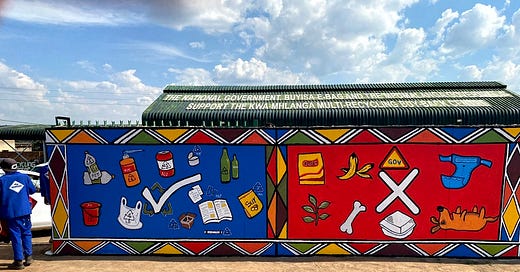Sing a song of plastic waste to make it go away
A pioneering collaboration used art, song and comedy to help a South African community tackle plastic blight
THERE'S a power to art or song or comedy; in South Africa that's been put to good use to save the environment from humanity's plastic crap.
A pilot programme in the Mpumalanga Province managed to divert seven tonnes of plastic waste from being dumped in the environment, all thanks to the power of human expression to make people stop and think.
Let's face it, we all need to think more when it comes to plastic. It's just so easy to discard, and often so inconvenient to do so responsibly; who among us, in the dizzying spin of everyday life pressures, has sufficient bandwidth left over to break the cycle?
Well, it can be done; as the programme sought to demonstrate.
The pilot, in the Thembisile Hani Local Municipality, was the result of a pioneering international collaboration of agencies, working with local people to encourage a change of behaviour.
Researchers from the UK University of Portsmouth’s Revolution Plastics team, and the South African Government's Department of Agriculture, Rural Development & Environmental Affairs (DARDLEA) partnered with another UK-based organisation, the charity WasteAid.
Creative collaboration
They combined creative ways to educate people about the dangers of dumping and burning waste with on-the-ground action to increase waste recycling. This included efforts to support informal waste collectors. The pilot also introduced community drop-off points for recyclable material.
“This is a great example of the positive outcomes that can be achieved through collaboration between the third sector, academia, and private sector,” said Ceris Turner-Bailes, WasteAid's chief executive.
“The educational and creative elements for this project made it almost impossible for people in the community to ignore our initiative. It sparked interest and helped facilitate important discussions on the steps people could take to improve waste collection and increase recycling.”
The pilot has made “promising strides” in tackling the problem, with two thirds of local people reporting a positive change in their environment as a direct result of the project.
What's more, the findings of a survey endorse the arts-based approach. The creation of murals, in particular, were found to be significant drivers in the project's success.
Apparently, the murals “sensitised” 86% of people who saw them; showing them how to separate waste, and nudging 80% of them to change their attitudes and behaviours. By the end of the project the amount of waste managed by burning or dumping had fallen by 27.7%.
Every little counts. The uncontrolled disposal of plastic waste in the area poses a severe threat to the environment, and to human health, with waste often burned, contributing to climate change and poor air quality.
“Sensitisation is a vital process for educating communities, raising awareness and inspiring behaviour change,” said Dr Cressida Bowyer, deputy director of Revolution Plastics.
“To make messaging more effective, it’s important for the message creators to reside in the target community, understand local social and cultural contexts, and actively participate in the production of campaign materials.”
Working closely with the local community, WasteAid implemented strategies to improve plastic waste collection, and boost the revenue for local collector groups.
The project focused on both supply-side factors, such as educating households on better waste separation and providing collection bins, and demand side factors, including training collectors on the types of plastics with value and promoting good business management.
Additionally, the project fostered connections with off-takers committed to purchasing plastic waste regularly from collectors.
Artistic sense
By embracing arts-based sensitisation methods, such as murals, music and street theatre skits, the partners delivering the project found the campaign was more accessible to old and young alike. The message was more easily digestible, and it encouraged open discussions with the community.
Collaborating with local stakeholders, including artists, musicians, and waste collectors, the campaign aimed to demonstrate the value of waste, and raise awareness about the harmful impacts of dumping and burning waste on human health.
Two murals were created in the project area. These featured clear graphical guides to aid recycling efforts and encourage separation of recyclables at source.
These murals were adorned with vibrant Ndebele patterns to resonate with the local culture, and effectively communicated the different types of plastics and other materials suitable for recycling.
From visual art to the quality of the human voice, the project partners soon recognised the power of music as a driver for social change.
A locally crafted song was composed and performed by talented local waste pickers and musicians, tapping into the emotional resonance that music brings.
With a “catchy” chorus and “captivating” video showcasing the murals, theatre skits and community events reinforced the campaign's core messages. The lyrics and performance reflect the pride that the waste collectors have in their work.
Video view
There may be a way to go yet in eradicating plastic waste – in this part of South Africa, as in the wider world – but the team behind the result feel the results are promising for the short time the pilot was in operation.
In a survey of the community, nearly 21% now use the local bins for better waste separation and segregation. More importantly, two-thirds said they had noted a positive change in their environment, with nearly half putting that down to the presence of the recycling bins.
So, all in all, you might say the project has shown it's something to sing about.
MC




